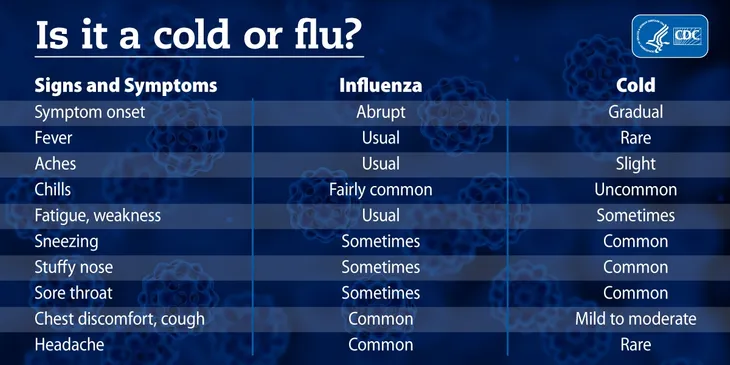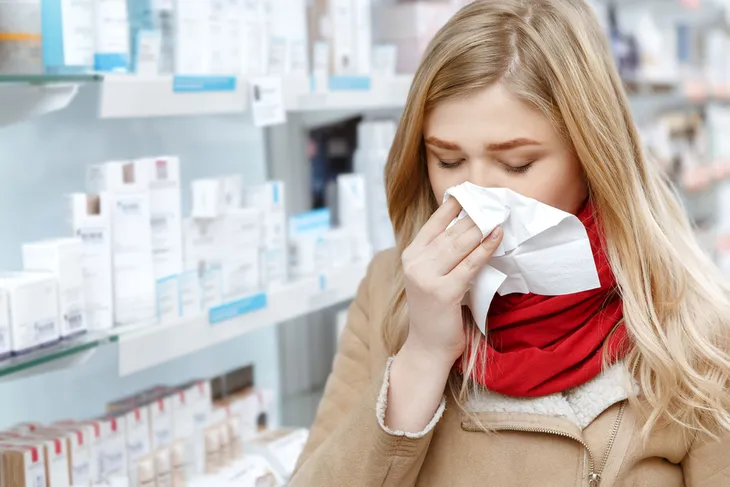Every year the flu comes back with a vengeance. Some flu seasons are better than others, but what never changes year after year is how it is spread, prevented, and treated. Even if it doesn’t seem like a particularly bad flu season, trust us when we say, it’s still lingering around, so you need to protect yourself and get informed!
The flu can range in severity depending on who catches it. For example, kids and the elderly can be particularly hard done by with the virus because of their weaker immune system. Even though it’s quite common and more often than not, it comes and goes no problem, it’s can still be a scary experience for a parent to watch their kid get sick. To avoid crowding hospitals or doctor offices, here are some tips for parents and adults in general on what to do if you get the flu…
Determine Whether It’s a Cold or the Flu…
This might seem silly, but it’s not uncommon to mix these two up. While the flu has several symptoms that are not present in a cold, there are some that overlap and the flu can be mild for some people, especially those who’ve had their flu shot. Someone who is only experiencing mild symptoms of the flu might confuse it with a bad cold. WebMD describes a cold as a milder respiratory illness than the flu, and while a cold can get particularly nasty with symptoms of a sore throat, runny nose, cough, and congestion, the flu will often make a person feel ill. While it is possible for a child to get a fever with a common cold, it will not occur in adults. The flu on the other hand will cause a fever, congestion, cough, body aches, and general malaise.
Another difference between the two is how it comes on and how long it lasts. A cold typically develops slowly and lasts about 10 days or so. The flu tends to come on hard and fast, but will begin to improve after about two to five days. However, WebMD notes that it’s not uncommon to feel run down for about a week or more.
 Centers for Disease Control and Prevention
Centers for Disease Control and PreventionAct Fast
The first thing to do when it comes to the flu is seek treatment, especially if that sick person is a child or an elderly person. To determine whether that should take place at home, at a doctor’s office, or in rare cases the emergency room, you need to determine whether you’re in a high risk group or if the illness is severe. Someone in a high risk group would be children under 5 (especially under the age of 2), adults over the age of 65, pregnant women, residents of nursing homes or long-term care facilities, or people with certain medical conditions.
If you qualify to be in the high risk group, then you should contact your healthcare professional as soon as possible. The only time you will rush to the emergency room is if you’re showing emergency warning signs which we will explain in the following slide.
When to See a Health Care Provider
When it comes to a person’s health, better safe than sorry, right? This isn’t always the case during the flu season! Each year the emergency room gets flooded with sick people and sometimes it’s unnecessary. The Centers for Disease Control and Prevention (CDC) warns about overcrowding the emergency room and that it’s best to leave it open to people who are extremely sick and in need for immediate attention. We understand that it can be quite frightening when a child is sick, and it’s true there are cases where the flu becomes severe and requires immediate medical attention, but this is rare. Most of the time it’s completely fine to treat the flu at home.
To know when to go to the emergency room, educate yourself on what is normal and what isn’t. The CDC lists fever, cough, sore throat, runny or stuffy nose, body aches, headache, chills, fatigue and sometimes diarrhea and vomiting as all normal symptoms of the flu. The source advises staying at home if your flu symptoms are mild or normal. The only time you should go to the emergency room is if you or your child are experiencing emergency warning signs.
Children with difficulty breathing, bluish skin, fever with rash, and are not drinking fluids, interacting with others, or unable to be soothed should seek medical attention. For infants it’s similar, but look for signs of fewer wet diapers than normal and no tears when they cry. For an adult the emergency signs are difficulty breathing, severe or persistent vomiting, confusion, dizziness, as well as pain in the abdomen and chest. Educate yourself on who qualifies for high risk. Visit the CDC website to find out more information on what the emergency warning signs are and who is at high risk.
Stay Home and Rest
There’s nothing worse than someone who is knowingly sick and spreading around their illness for others to catch it. Please don’t be this person! When you’re sick with the flu, you should stay home and get lots of rest. Unfortunately, there is no cure for the flu, but there are lots of things a person can do to make themselves feel better. The first thing on WebMD’s list is “take it easy” followed by “go to bed.”
When someone is sick with the flu, their body is working overtime to fight off the infection. You’ll need to conserve energy in order to get better, so lots of rest is necessary. Take some time off work, curl up on the couch or in bed and relax. Just because you’re at home all day and off work, it doesn’t mean you should be breaking curfew and staying up all night. You should spend most of the sleeping. Lack of sleep makes the immune system weak which will only make the flu last longer. Go to bed early and take naps during the day.
How Long Should You Stay Home?
The CDC recommends staying home for at least 24 hours after the last signs of your fever are gone. The only time you should leave your house is to seek medical attention when needed or other necessities. It’s also important to note that this rule is based off a fever going away on its own, not with the help of medication. “Your fever should be gone without the need to use a fever-reducing medicine, such as Tylenol. Until then, you should stay home from work, school, travel, shopping, social events, and public gatherings,” writes the CDC.
Avoid Contact with Others
You’d be surprised how many sick people still go out and about, especially those in the workforce! There are lots of people who only get limited paid sick days (or none at all), so taking a day off work isn’t in their budget. Unfortunately, it’s necessary. The flu is highly contagious and can be easily spread from person to person. Just think of how it ended up with you! It’s especially contagious if a sick person is sneezing and coughing into the air around them.
According to Dr. Amesh Adalja, MD, an infectious disease physician, spokesperson for the Infectious Diseases Society of American, and senior scholar at Johns Hopkins University for Healthy and Security, the flu virus can travel 3-feet or more in the air through small droplets. “The flu virus is a parasite that hangs around in respiratory secretions that travel through the air in small droplets; when projected by a cough or sneeze, they can fly about three feet before gravity takes over,” says Dr. Adalja to Cosmopolitan. These droplets could easily land on surfaces around them where they’re just waiting to be picked up by the next person who will then inadvertently infect themselves.
Drink Lots of Fluids
You might not feel like eating and drinking much, but it’s really important to drink lots of fluids when you’re suffering from the flu. A diet with lots of fluids will help keep you from getting dehydrated, especially if you’re suffering from a high fever, vomiting and or have diarrhea.
Treat with Over-The-Counter Medicines
There are several over-the-counter medications that are available to help treat the flu. None of these will cure the flu, but they’ll work to ease the symptoms associated with this illness. It’ll definitely help for those who are having trouble sleeping at night because their symptoms are keeping them up. The first option is to take pain relievers to lower a fever and dull some of those aches and pains. Most doctors will recommend medication like acetaminophen which includes Tylenol, ibuprofen, Advil, Motrin, and for adults only, aspirin.
The flu can also cause a sore throat which can be treated with Lozenges or cough drops. Decongestants will help “shrink blood vessels in your nose so your airways can open up,” writes WebMD. And antihistamines can help dry up a runny nose by blocking the chemical in the body that causes sneezing and sniffling.
Antiviral Medication
Unlike a cold, the flu comes on quite quickly and causes extreme exhaustion, aches, and a high fever. Since it comes on so quickly, it’s almost impossible to get ahead of the illness. If you’re able to distinguish the symptoms within the first 48 hours, there are antiviral drugs that will fight against the flu virus. These drugs can only be prescribed by a doctor and are reserved for people who are extremely sick or those who are at risk for complications.
Antiviral drugs won’t cure the flu, they will help ease the symptoms, minimize complications, and hopefully shorten the duration of the illness. “Antiviral treatment works best when started soon after the flu illness begins. When treatment is started within two days of becoming sick with flu symptoms, antiviral drugs can lessen fever and symptoms and shorten the time you are sick by about one day. They also may reduce the risk of complications such as ear infections in children, respiratory complications requiring antibiotics, and hospitalization in adults,” writes the CDC. For the average person, getting the flu means staying home, loading up on fluids, taking over-the-counter drugs (not antiviral meds), and getting lots of rest.
Clean and Disinfect Surfaces
In addition to staying away from others who aren’t sick, “Cleaning with soap and water to remove dirt and most of the germs is usually enough. But, when it comes to flu germs, you will want to disinfect for an extra level of protection. Use a household cleaner. Make sure the label says that it kills influenza viruses,” writes the New York State Department of Health.
If someone in the house or workspace is sick, the New York State Department of Health advises cleaning with disposable paper towels or cloth towels that can be washed immediately after. This way you won’t spread the virus around the house!
Wash Your Hands
The common theme here is that the flu is highly contagious. Not only should a person who’s suffering from the flu stay away from others and keep all communal surfaces clean, they should also be washing their hands all the time. This is because every time a person coughs or sneezes they are spreading their germs which can spread up to 3-feet!
This is also an important rule to follow for people who aren’t sick and are trying to keep it that way. Wash your hands frequently, especially after visiting public or communal places. You have no idea who has passed through recently and what germs are lurking around on doorknobs or staircases. Even though you can’t get contaminated through skin to skin contact, if you touch an infected surface and then either your eyes, nose, or mouth, you could transfer the virus into your system.
What to Avoid
While we’ve now listed all of the things a person should do when treating themselves, now we’ll talk about what not to do. As we already mentioned, when someone is suffering from the flu, their immune system is working overtime to fight the infection. To help your body do what it needs to do to get better, don’t feed it anything that will slow down the healing process. Alcohol and coffee will only make your body more dehydrated and weaken the immune system. We already mentioned that you need to get lots of rest, so staying up late or doing anything active is another no-go.
A sore throat is one of the painful symptoms of the flu, so avoid eating foods that have a rough texture like crunchy crackers, chips, or spicy foods. The best foods to eat are the ones are easy to digest, will give the body a much needed energy boost, and have lots of nutrients. Healthline lists broth, chicken soup, garlic, yogurt, vitamin C-containing fruits, leafy greens, broccoli, oatmeal, and spices.














